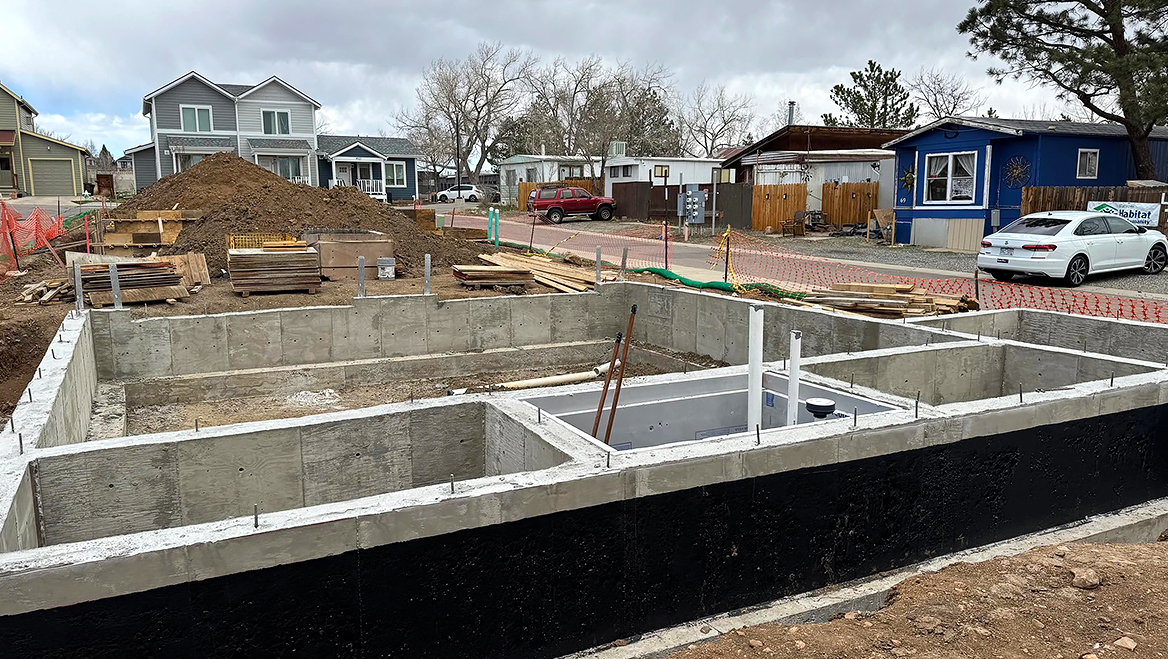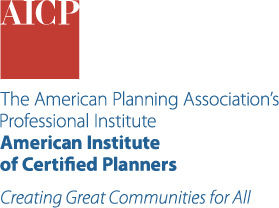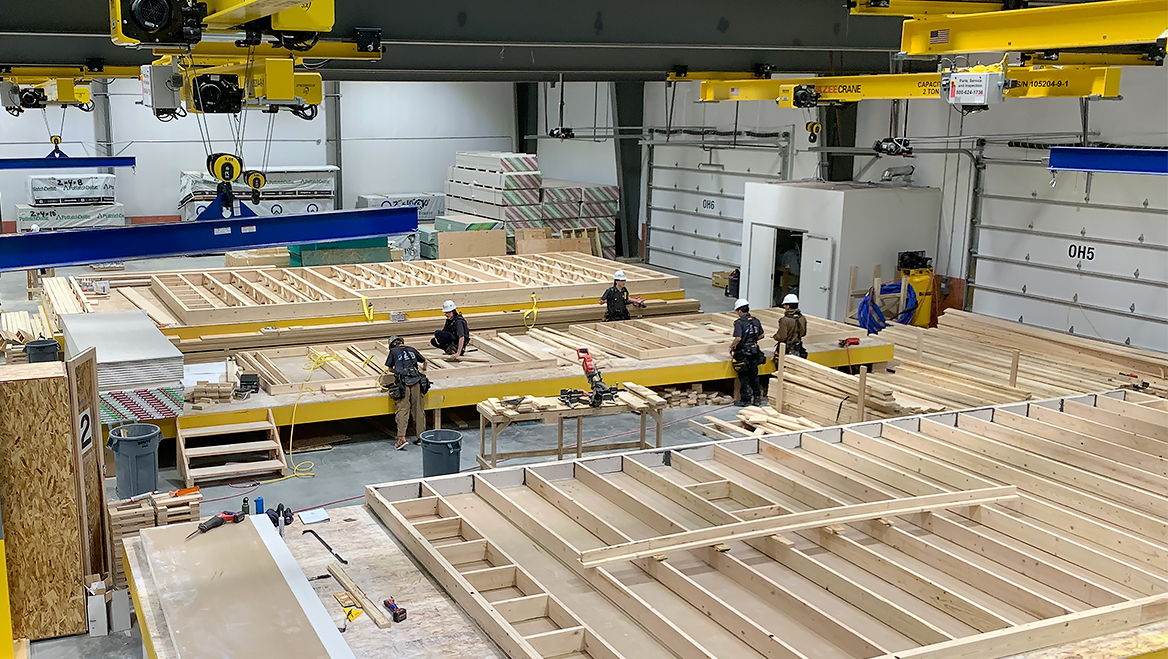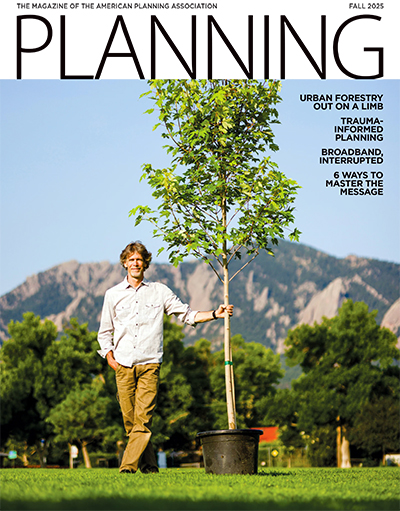Oct. 23, 2025
In a metal building on a former school bus parking lot in Boulder, Colorado, high school senior Sophia McPhee frames walls, runs electrical wires, and installs plumbing for new modular homes three days a week.
"The most challenging thing is that all of the work has to be perfect," she says. "There's really no room for error, because somebody is going to actually live in that house."
McPhee is one of 40 construction tech students who work alongside volunteers at BoulderMOD, a net-zero modular home factory born of an innovative partnership between the city, Boulder Valley School District, and Flatirons Habitat for Humanity. Tapping into the growing modular home trend, the initiative aims to increase Boulder's affordable housing supply while creating a pipeline of new construction trades workers.
"Instead of building out in a field where people are swinging a hammer in 90-degree heat or 10-degree cold, they're doing it in a climate-controlled factory," says Jay Sugnet, the Boulder senior housing manager who oversaw BoulderMOD's creation.
The 31,375-square-foot factory opened in October 2024, and volunteers and students began construction work in February. Once at full production, the facility is planned to turn out 24 energy-efficient homes a year for Boulder and surrounding communities, with the capacity to double that, says Daniel Sissom, who manages the factory for Flatirons Habitat for Humanity. Families are expected to move into the first two duplex-style townhomes in November.
At first, McPhee doubted a factory half the size of a football field could produce so many homes so quickly. But after seeing "how many houses they can fit in the space and how quickly the process moves," she's convinced.
Modular housing on the rise
Modular homes are transported to the building site using specialized equipment, similarly to manufactured homes. However, manufactured homes are built on a permanent steel chassis and set on blocks, while modular homes are constructed in sections that are put together and placed on concrete foundations or crawl spaces. Modular homes also must be built to state standards, unlike manufactured homes, which follow federal housing codes.
Modular construction is gaining traction nationally as a faster, more affordable way to build at scale, says Arica Young, PhD, director of housing access and affordability for the Lincoln Institute of Land Policy. The U.S. modular construction market is expected to hit $25.4 billion by 2029, outpacing the broader construction industry's growth by 1.3 percent, according to a 2025 Modular Building Institute report.
"When people wanted to make that step from renting to ownership, we found a lot of people were leaving."— Jay Sugnet, Boulder senior housing manager
Communities like Brownsville, Texas, and Detroit's North Corktown neighborhood are among those experimenting with factory construction for attainable housing, Young says, but misconceptions about quality and outdated regulations remain major hurdles for modular construction nationwide. "If you can't expedite the permitting inspection process, it doesn't matter how you're building the house," she says.
Proponents say modular homes are indistinguishable from site-built ones, and the biggest advantage is speed. BoulderMOD can produce two houses a month, compared to two a year for conventional Habitat for Humanity projects, Sissom says. There's also less neighborhood disruption with modular housing, because homes can be delivered and set up in a day, and ready for move-in within two weeks.
Boulder's housing crunch
Home to more than 106,000 residents, Boulder has some of the nation's highest housing costs, with a median listing price of $1.1 million as of August 2025. BoulderMOD is part of a broader strategy introduced in 2016 to increase affordable home ownership for middle-income residents, Sugnet says.
"We were doing just fine on the super-high end, and better than most in terms of providing rental opportunities for people earning 60 percent of the area median income (AMI) and below," he says. However, "when people wanted to make that step from renting to ownership, we found a lot of people were leaving."
Boulder also needed an efficient way to replace aging, unsafe mobile homes in Ponderosa Mobile Home Park, where the first 10 modular homes are slated to go. The city purchased the park in 2017 with a goal of long-term stabilization after severe flooding damaged it in 2013.

In the Ponderosa community, modular housing replaces outdated infrastructure and introduces energy-efficient housing. Photo courtesy of Flatirons Habitat for Humanity.
Planners turned to modular home construction after visiting a factory in Vermont. The city initially considered using private factories in nearby states to source the homes, but shipping them to Boulder was too expensive. The local factory allows for "more control over what we build and when," Sugnet says.
Finding a location was the biggest challenge. "If we had to buy the land, there's no way that we would have been able to finance it," Sugnet explains. City officials approached the Boulder Valley School District about building a factory on land it owned, just steps from its construction tech classrooms. The school district agreed to lease the property to the city for a nominal fee in exchange for using the factory as a classroom.
Building a workforce
The impact of modular construction isn't limited to the housing market. It also may be an answer to an aging workforce, Sugnet says. "Everything's done at chest level. It's just a much more efficient way for the human body to build," he says.
For students like McPhee, BoulderMOD has opened new career pathways. Classes follow a Home Builders Institute curriculum, so students can earn pre-apprenticeship certifications. McPhee plans to graduate with a core residential building certification, as well as certificates in carpentry and electrical, says Darrin Rasmussen, a construction trades instructor with Boulder Valley School District.
Sissom, the factory manager, hopes BoulderMOD can become a national model for Habitat for Humanity and others looking to train the next generation of home builders.
"The students are really good workers, and once we learn how to do it, we do a really good job," McPhee says. Knowing their work is helping families own homes "adds value to everything we do."




